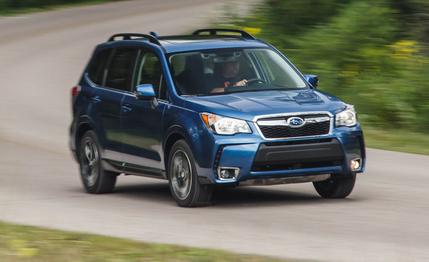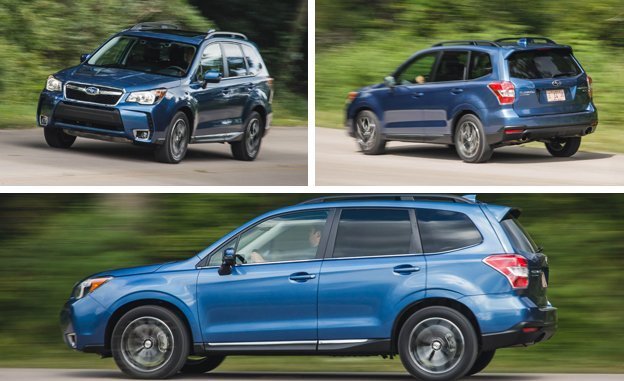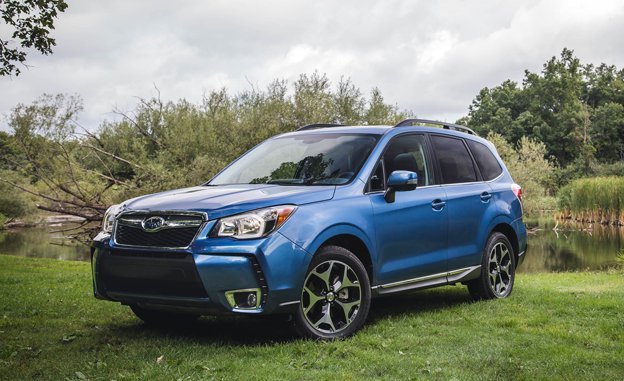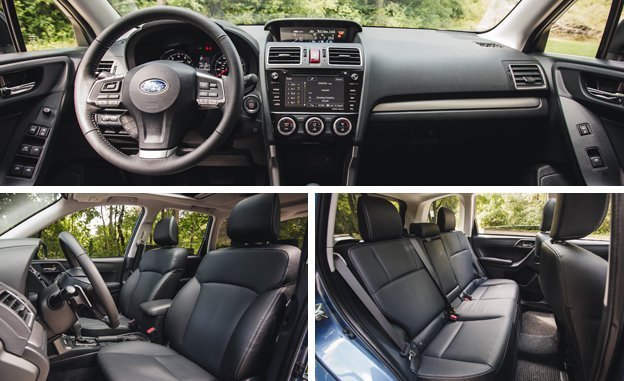
 Instrumented Test
Instrumented Test
No one mistakes Subaru for a peddler of luxury goods. Its customers are practical, down-to-earth folks more likely to shop from the REI and Duluth Trading catalogs than to wear high couture, and we’ve taken a few mild pokes at granola and sensible shoes in our reviews of Subarus over the years.
We had a peculiar soft spot for the Forester XT of a decade ago. It was equipped with a turbocharged engine and a manual transmission, making it sort of a high-riding WRX, a backwoods-rallying station wagon. The 2016 2.0XT Touring model tested here is not that car. Although still upright, rational, and off-road capable, it’s all grown up. While Subaru cultists bemoan its standard CVT and the missing hood scoop, this Forester is a quicker, quieter, better machine in nearly every way. Subaru’s former agricultural character has been banished in favor of a sophisticated, modern crossover with much broader appeal.


Within the hot-selling compact-crossover segment, Subaru has a certifiable hit on its hands with the latest Forester, introduced for 2014. Making it a bit larger, more rigid, and quieter while upgrading its interior and features paid off with a big leap forward in sales. Forester volume was up more than 60 percent in 2013, when it passed the Outback as Subaru’s bestselling model, and the Forester continues to gain 8 to 10 percent over year-ago figures. Some of that is attributable to the growth of the segment generally, but the Forester is gaining market share even as the volume leaders—the Honda CR-V and the Ford Escape—stagnate. Subaru peddled 55 percent more Foresters in August 2015 as it did two years earlier.
The sales success isn’t really attributable to the 2.0XT, though. Less than 10 percent of Foresters are XTs; most buyers go for the less-expensive 2.5i. With its 170 horsepower and a CVT, a Forester 2.5i ranked third in a three-way comparison against the Toyota RAV4 and our favorite in this category, the Mazda CX-5. Its downfalls in that test—lackluster acceleration, the droning effect of the CVT’s operation, and a fussy infotainment system—are all addressed by the latest 2.0XT Touring.
The 2.0-liter direct-injected turbocharged boxer four generates 250 horsepower. Smooth, strong, and quiet except for a grainy texture at idle (felt in the floor more than heard), it propelled this Forester from zero to 60 mph in 6.3 seconds and on to a quarter-mile in 15.0 at 97 mph. The sprint to 60 mph is not only a healthy 2.3 seconds ahead of the equivalent 2.5i, it also represents a significant 0.7-second edge over the Escape with its 2.0-liter EcoBoost and a 1.4-second advantage over the CX-5 with its 2.5-liter Skyactiv four. The 2.0XT even outruns the 3.2-liter V-6 Jeep Cherokee Trailhawk all the way down the drag strip.


Where our test drivers complained about the 2.5i CVT’s operation nearly as loudly as the naturally aspirated four-cylinder droned under full throttle, the 2.0XT’s electronic programming renders the transmission choice a moot point. While we’d still be happier if Subaru would offer a six-speed manual (and we wonder if that might allow for a tow rating higher than this model’s 1500-pound limit), the XT has a simulated stepped-gear operation that lesser Foresters lack. In its Intelligent (normal) and Sport settings—which also affect throttle mapping—it mimics a six-speed automatic, and in Sport Sharp it allows manual selection of eight ratios via shift paddles. It does a better job than Honda’s CR-V does of masking the CVT’s more objectionable characteristics, particularly in ordinary driving.
Alas, acceleration tests were the only bragging point for Subaru at the track, where the numbers showed the Forester on the trailing edge of the segment in both braking and roadholding. Stopping from 70 mph took 180 feet, and the skidpad result of only 0.75 g exposed moderate understeer and notable body roll, despite the “sport-tuned” suspension that comes on the 2.0XT. Both results fell short of even the Forester 2.5i’s test figures. This car wore Bridgestone Duelers on its 18-inch rims, while the lesser model had Yokohama Geolandars on 17s. Both tire choices are known more for off-road prowess than are the grippier, street-oriented tires fitted to the nimbler CX-5 and Escape, although we should also note that both Foresters exhibited better suppression of road noise than in previous generations.
With 8.7 inches of ground clearance and a handy X-Mode program activated via a console button to enhance off-road performance, the Forester retains credibility in the boonies, a supposed SUV attribute many competitors ignore. It’s no rock-crawling Jeep Wrangler, but it’s willing to wander farther off pavement than a gravel driveway.


Subaru’s outdoorsy airs notwithstanding, the 2016 version of the 2.0XT Touring also offers advanced safety features for highway driving. The EyeSight package (a $1395 option that also brings navigation) includes adaptive cruise control, pre-collision braking, lane-departure warning, and fog lamps that turn with the steering wheel. Here’s where boxy, no-pretensions styling pays off: With a big glass area, narrow pillars, and big mirrors, there aren’t really any blind spots an attentive driver needs electronics to overcome.
The adaptive cruise can brake the car to a full stop and it also sends a message when the car ahead has resumed motion. There are buttons to deactivate individual features, such as the sometimes annoying lane-departure alarm, and more to be managed via menus on the 7.0-inch touch screen. The latter employs smartphone-like swipe and pinch gestures that make Subaru’s latest Starlink infotainment systems easier to use than was the case with the 2015 model. It still has its quirks but it’s no longer infuriatingly obtuse.
The Forester 2.0XT Touring trim includes almost everything in Subaru’s playbook as standard. The only option is the aforementioned EyeSight+Navigation package, which brings the all-in sticker to just over $36,000. Pricey? Not when compared with the loaded-up versions of the CR-V and Escape, but the latest Hyundai and Kia entries, strong on content-per-dollar, are set to gain market share, too. This Forester plays to Subaru’s traditional strengths while adding refinement and sophistication on par with the bigger players. No wonder it’s no longer the Subaru fans’ secret.